Foot massage: Ayurvedic Benefits, How To Do, Importance
By Dr Raghuram Y.S. MD (Ay).
‘The foot feels the foot when it feels the ground’ says Lord Buddha.
You feel so grounded, rooted, secured and belonging to this Earth only when you put your foot on the ground. It is your feet which connects the being in you to the Earth to which you belong to.
Eastern spiritual practices, mainly India, believe that our body and soul are connected and embodied in our feet. In Indian culture, therefore, touching, washing and kissing the feet of teachers, elders and parents show love and respect to another body and soul. Even across the whole Asia we can find feet imprints of various Gods and Buddha where devotees gather to worship.
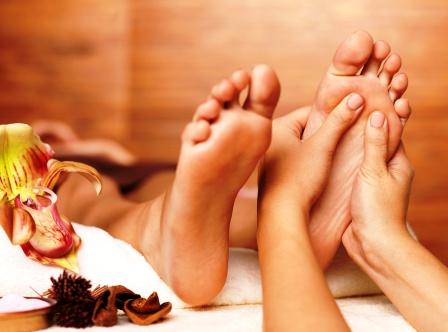
Why is feet given so much importance?
Wise men say that the personality of an individual is weighed by looking at his feet…
Pada or foot has been given utmost importance in Indian customs, tradition and medicine. It is not just because foot is an essential part of our body. Ayurveda explains that the human body is inverted trees wherein the roots lie at the top (head) and the branches (upper and lower limbs) attached to the trunk (trunk of the body) are directed downwards. The trees are nurtured at their roots but the fruits are obtained always in their branches.
Similarly in the human body if we take good care of the roots we obtain their fruits in the branches. That also means to tell that the essence of the tree called body (in the form of fruits) is concentrated in its branches i.e. hands and legs.
Therefore it is our responsibility not only to enjoy the fruits (co-ordinated activities like walking, holding etc and fine movements in the hands and legs helping us to do delicate work) but also take care of our hands and feet without which none of our daily activities are possible.
In a tree, a diseased branch might reflect diseased roots. Similarly in our body, any problem or disease or disorder in our foot might also reflect a serious problem somewhere proximal to it, may be in the head (brain) too where its governing centers are seated. Foot care and maintenance of foot health also means that there is a retrograde improvisation of the health in other organs proximal to it. Thus foot health is connected to the general well being.
There are many therapies and medicines oriented towards a comprehensive foot-care which have evolved over a period of time. Padabhyanga explained in Ayurveda is the mother of all therapies.
Table of Contents
Padabhyanga
What is Padabhyanga?
Padabhyanga is a Sanskrit term made up of 2 root words
- Pada – means foot
- Abhyanga – means massage using medicated oils
Foot massage? What is there in it?
You may feel so, but Padabhyanga is much more than what its root meaning shows
It is a concept beyond massage. Padabyanga is a holistic therapy and a religious approach towards an effective psychosomatic healing.
Padabhyanga
– foot massage is a part of Ayurvedic traditional treatment. Reflexology, Acupuncture, Acupressure and Pedicure seems to have originated from this ancient art of healing.
When is foot massage done?
- It can be done at any time of the day
- It is more effective when it is done at end part of the evening or at night before going to bed
- It is also done as a part and parcel of the Sarva-Abhyanga (whole body oil massage)
- Since Abhyanga is advised to be done on a daily basis for maintenance of good health, Padabhyanga too can be done on a daily basis
Importance
Importance of Padabhyanga:
Padabyang immediately and effectively alleviates:
- Pada kharatvam – Roughness of the foot
- Pada Stabdhata – Stiffness of the foot
- Pada roukshyam – Dryness of the foot
- Pada shramam – Tiredness / fatigue of foot
- Pada Supti – Numbness and tingling of the foot and leg
Padabhyang also provides the below said benefits:
- Pada saukumaryam – Tenderness and attractiveness of the foot
- Pada balam – Strength in the foot, Strengthens the joints and soft tissues in the foot
- Pada Sthairyam – Stability in the foot
- Drishti prasada – Good and accurate vision, pleasantness of vision and eye health, Helps in improving and maintaining good eyesight (good for eyes)
- Marutopashama – Controls and balances Vayu
Indications
Foot massage with oil prevents and cures –
- Gridhrasi – Sciatica
- Pada Sphutana – Cures cracks in the foot, prevents and cures cracked heels and fissures.
- Sira sankocha – constriction of blood vessels, improves blood circulation (Improves peripheral circulation)
- Snayu sankocha – Constriction / spasm / irritation of ligaments, tendons and nerves (Removes contraction of muscles, ligaments and vessels of the feet)
Benefits
Other benefits of Padabhyanga –
- Heals the Marma’s (Releases negative energy from marmas)
- Soothes the nerves, Relaxes and revitalizes the CNS
- Relieves foot pain
- Prevents many diseases occurring in the foot
- Helps in easy locomotion and successful accomplishment of all our day to day activities
- Calms agitated mind and acts as a stress reliever
- Reduces stress, anxiety
- Activates our immune system
- Gives good hearing capacity
- Promotes sleep and cures insomnia, cures sleep disorders
- Aids foot health, alleviates pain, improves muscle tone, nourishes, prevents and cures dryness and roughness of the skin
- Relieves fatigue and cramps
- Balances doshas
- Good for restless leg syndrome
- Removes Anxiety
- Removes Depression
- Alleviates Diabetic neuropathy
- Good for Epilepsy
- Nourishes skin
- Relieves Hypertension
- Cures Hemiplegia & Paraplegia
- Numbness of feet and legs
- Cures headaches
- Activates metabolism
- Reduces symptoms of Pre-Menstrual Syndrome (PMS)
- Reduces oedema when done in pregnant women
- Prevents onset of degeneration
Ashtanga Hridaya identifies 4 major nerves in the feet that connect to the eyes. These nerves helps maintain good eyesight and relieve eyestrain when subjected to soothing therapies like Padabhyanga.
According to reflexology, foot massages release any blocks that can hold back energy that should be flowing through the body freely
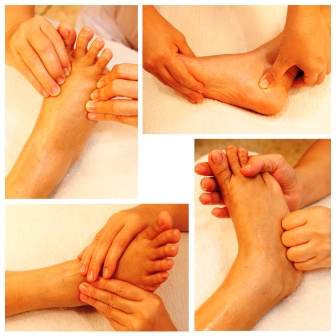
Method of Padabhyanga
How is Padabhyanga done?
Padabhyanga is done in the below said method –
Purvakarma
Purvakarma (Pre-treatment procedures): This includes –
Preparation of the patient:
- The patient is thoroughly examined. The Prakriti (basic constitution) and Vikriti (details of morbidity) are documented in detail. The disease is also examined. The treatment line-up and medicines which need to be used are enlisted.
- Patient is given a Sadhyo-virechana (instant purgation) for detoxification
Preparation for the treatment:
Materials needed for the treatment are collected beforehand. They are:
- Taila (medicated oil), Ghee (medicated ghee) or both suitable to the disease and diseased
- Stove, bowls, vessels, water etc
- Milk and Dashamula Kashayam, Laksha churna etc for preparing processed milk (for ksheeradhara if needed)
Pradhana Karma
Pradhana Karma (Treatment proper):
- The medicated oil / ghee is passively made warm by placing a small bowl having oil in a vessel with hot water
- The oil / ghee is liberally applied to the feet, including the soles, heel, ankle joint and legs (between knee and ankle)
- While attending the ankle, oil is rubbed energetically into the whole joint including the bones of the joint and Achilles tendon (a cord like structure at the back of your foot connecting the calf muscles of your leg to your heel). Knead and stroke the tendon repeatedly.
- While on the top of the foot (dorsum) slowly give a soothing massage from the ankle joint moving downwards towards the toes. Massage the spaces between each of the tendons while supporting the heel with the other hand.
- Coming to the toes, pinch and massage each toe between your fingers from its root to the tip. Start from the big toe and end with the small one.
- Next end by massaging the soles. If you are incorporating reflexology in padabhyanga, have a reflexology chart for reference. Work on the head and neck areas, shoulder, spine and the points referring to any painful part / organ in the body. End by massaging the kidney point. This will help detoxify your body.
- Massage is done with hands by applying moderate pressure (pressure is altered and adjusted according to the nature and intensity of pain)
- Circular motions are done around the joints and vertical massage is done over the legs (from above downwards)
- It is better that a single masseur does Padabhyanga in both feet so that the synchronicity is maintained
- If reflexology is combined with padabhyanga, massage is also given over the pressure points as explained in reflexology
- Each foot is attended for 15-20 minutes
Paschat Karma
Paschat Karma (Post-treatment procedures):
- The oil is erased and given a hot water dip
- Alternatively hot salt water is given for foot dip
- Dashamoola Ksheeradhara – Milk processed with Dashamoola herbs and Laksha churna is used for streamed pouring
- Ishtika Sweda – Hot brick fomentation can be done if Padabhyanga is implemented in painful conditions like plantar fasciitis, calcaneal spur (heel pain) etc
Bricks are heated red hot on fire and herbal decoctions like Dashamula Kashayam etc are poured on the bricks. The foot of the person is exposed to the fumes coming from the brick. This is done following padabhyanga.
- Nitya Virechana – Daily metered dose of purgation with purgative decoctions or oils like Gandharvahastadi Kashayam, Gandharvahastadi Eranda tailam, Nimbamritadi Eranda Tailam etc can be administered if a small amount of detoxification is essential on a daily basis or if morbid Vata and Pitta need to be tackled
- Basti: Medicated decoctions and oils can be used for giving enemas to pacify aggravated Vata and Pitta
Oils, ghees
Oils / ghee used for Padabhyanga:
For general foot health:
- Tila taila (sesame oil)
- Go ghrita (Cow ghee) – useful in disorders with Vata and Pitta aggravation such as neuritis associated with burning sensation, diabetic neuropathy etc.
- Ksheerabala tailam
- Eranda tailam (castor oil)
In pathological manifestations like pain, burning sensation, swelling, stiffness etc:
- Mahamasha tailam
- Ksheerabala tailam
- Mahanarayana tailam
- Kottamchukkadi tailam
- Murivenna
- Pinda tailam
- Tiktaka ghritam
- Guggulutiktaka ghritam etc
To keep padabhyanga simple with easily available oils:
- When Vata is predominant or for those with Vata constitution – Sesame oil, ghee or olive oil is used
- When Pitta is predominant or for those with Pitta constitution – ghee, coconut oil or sunflower oil is used
- When Kapha is predominant or for those with Kapha constitution – ghee, sesame oil or jojoba oil is used
Other points of interest:
- Tila taila (sesame oil) and Brahmi Taila provide good relaxation and induce good sleep. Brahmi Taila can also be used over the head in the form of Shiro-abhyanga (head massage) simultaneously.
- Sarshapa taila (mustard oil) prevents the dryness occurring in the cold season and athlete’s foot
- Essential oils of rosemary and lavender added to base oils like tila taila works wonderfully in terms of relaxing the foot and body following massage
Padabhyanga variants
Other forms / methods (variants of padabhyanga):
Kasa bowl:
Metals and metal equipment’s are extensively used in Ayurvedic treatments. Metallic bowls called Kasa Bowl are used for Padabhyanga. These bowls are usually made up of metals like copper and tin.
Kasa bowl
The word Kasa (or kansya, Kansa, Kasa) is derived from the Sanskrit word Kansya which means ‘bronze’
The bowl is traditionally meant to contain seven metals that relate to the various body tissues. However it is mainly composed of 2 metals – copper (major part) and tin (minor part) – literally a bronze bowl. This is also called Kansa Vatki Foot Massage. Massage with it balances the tridosha’s.
How is it used?
The Kasa bowl is made hot and dipped in medicated oil until its temperature drops down to tolerable heat. The bowl is then brought in contact with plantar surface of the foot (bottom of your feet) and massaged with circular motions and strokes.
Alternately the Kasa bowl is dipped in warm oil. This well oiled bowl is rubbed on the plantar surface with synchronous circular motions.
Benefits of Kasa bowl foot massage:
- Provides all benefits of Padabhyanga
- Helps to draw the toxins from the body
- Balances foot and body temperature
- When it is technically used on Marma points or reflexology points it has wonderful results
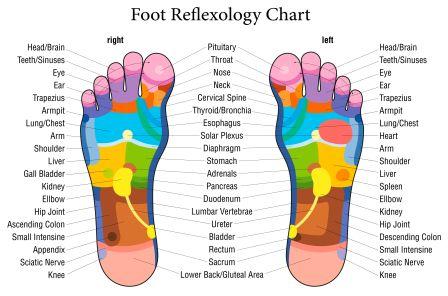
Marma Therapy
- This is a name given to the massage and reflexology techniques done on foot and hand (padabhyanga and hastabhyanga) though the Marma (vital points) points are spread out all through the body and are 107 in number. We can find at least 5 important Marmas in foot and hand as discussed above. Marmas, as already explained have an integrated relationship with the other marmas, nadis and chakras.
- Marmas or marma points are vital energy centres or remote points of energy control that are located throughout the body. They have a considerable impact on our health and well being. The marma points directly influence the function of the internal organs of the body. They also influence the relationships between the organs.
- It is the theory of Marma vijgnana explained in Ayurveda that has become the base of the origin of acupressure, acupuncture and reflexology treatments. Thus it can be said that the Marma points include in them all the reflexology, acupuncture and acupressure points. That also means to tell that when we are conducting acupuncture, acupressure or reflexology therapies on the patients, we are only dealing with the marmas and trying to soothe them thereby re-establishing the free flow of energy in all the energy channels of the body.
- Marma therapy is also said to detoxify and rejuvenate our system. Frawley et al says ‘Through working on marma points, we can control Prana. Through Prana, we can control our sensory and motor organs and eventually our entire mind-body complex’ Also is said ‘Treating the marmas can release negative emotions and remove mental blocks, including those of a subconscious nature (like addictions). This means that there is an important psychological side to their treatment’ Read more about Marma therapy
- A combination where in reflexology is incorporated into the ancient Padabhyanga procedure is often called as ‘Ayurvedic Reflexology’. The combination forms an effective combination towards foot care. The benefits obtained will of course be magnified.
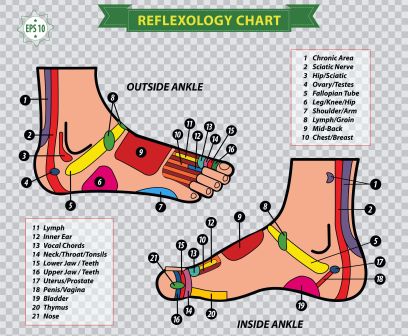
Padabhyanga contraindications
Contra-indications for padabhyanga:
As you can observe, below are the conditions even when oil massage to whole body is contra indicated.
- Fever
- Cold
- Flue
- Indigestion
- Toxin induced coma
- Lymphatic infection
- Blood infection (septicaemia)
- Thrombosis
- Thrombo-phlebitis
- Acute trauma to foot (severe bruising, severe sprains and strains, fractures, lacerations, burns etc)
- Abnormal skin conditions (weeping eczema, dermatitis, open wounds and sores, inflammatory skin conditions, fungal infections, warts)
- Circulatory disorders of lower limbs (severe varicose veins, inflammatory conditions of the vessels, thrombosis)
Healing effect of Padabhyanga
How does Padabhyanga act and provide relief?
Healing effect of Padabhyanga on Chakras, Nadis and Prana:
- Chakras are imaginary spinning wheels which are related to the energy flow in our body and mind. They are spinning in our aura. They are 6 in number (more chakras have been identified by modern day stalwarts) and are placed one above the other from the area of our tailbone to the crown of our head and a few inches above it. if theses chakras are spinning properly a constant energy is kept circulating within us.
- Nadis are again a complicated network of fine energy pathways. They maintain the energy levels within the body and are thus responsible for our well being.
- Wellness and the ability to heal are dependent upon the unimpeded movement of energy within the body. This movement of energy without interruption is taken care of by Chakras and Nadis when they are functioning in a balanced way.
- Apart from this, the body and mind are supplied with a vital life force known as Prana. Prana provides the whole being of ours with the essential energetic nourishment. Padabhyanga soothes vayu and removes the blocks in the body, thus enabling a free circulation of prana (the vital life element or energy) all over. Thus we feel energized after feet massage.
- Padabhyanga also soothes the nadis which are energy transmitting pathways all over the body. The mutually connected system of nadis regains a physiological alignment and relaxes the whole body following feet massage. The blocks in the aura get released once the mechanism and feeling of well being is conferred all through the body due to the impact of Padabhyanga. The Shat Chakras regain their normal spin and maintain the energy of our aura.
- Indian medicinal scriptures explain that ‘Just as the snakes fear going to a place occupied by eagles, diseases do not go near one who massages his legs and feet before sleeping’
Can Padabhyanga relieve chronic muscle pain and joint pain?
Foot pain cause chronic muscle and joint pain in the entire body
- Yes, your foot pain can cause muscle and joint pain in the entire body.
- About 80% of people are born with 1 or 2 abnormal foot structures – the Rothbarts Foot and / or Preclinical Clubfoot Deformity.
- Many doctors and healthcare providers are unaware about this. They are the inherited foot structures that predispose many people to chronic muscle and joint pain. If you are suffering with chronic muscle and joint pain, the probability is high that you were born with one of these 2 common foot structures.
- This indicates that in at least 80% of people, the body pain and joint pains which are not responding to any medication or therapies belong to the above said foot structures. If foot is producing pain all over the body, relief provided to the foot also reduces the muscle and joint pains.
- This also means that treatments like Padabhyanga when done in a religious manner, provides relief to chronic muscle and joint pain located all through the body.
Cranio sacral system theory
The Cranial-sacral system theory in Padabhyanga:
- Padabhyanga might work by correcting the functioning of the cranial-sacral axis or system.
- The cranial-sacral system is comprised of bones, membranes and cerebrospinal fluid that surround, nourish and protect the brain, spinal cord and sacrum. This system works with the Central Nervous System (CNS). This system connects cranium to the sacrum and thus the head to the toe.
- Fascia is a web of connective tissue that surrounds everything in the body – the muscles, blood vessels, nerves and the organs. The cranial-sacral system is also made up of such fascia / membranes. If there is any abnormal tension on this fascia, there will also be pressure on the nerves and blood flow.
- If the fascia in the foot and toes is constricted, the tensions or pressures on the feet will lead to tension all the way up in the legs, causing pressure on the back and neck and on the fascia and membranes of the cranial-sacral system. This will have negative and depressing effect on the ‘feel good hormones’ and can cause grumpiness (being cranky or fussy).
- Padabhyanga relieves the tensions on the foot fascia and thus creates a retrograde release phenomenon on the cranial-sacral system and their fascia. This relaxes the nerves and eases the blood flow. This in turn relieves us from chronic pain and grumpiness. Thus foot oil massage helps in providing psycho-somatic relief.
Reflexology connection
- Reflexology is a science which seems to be derived from the core of Ayurvedic knowledge. It is a kind of foot massage based on the principles of traditional Chinese medicine. According to them, the foot consists of reflex points that correspond to every part, gland and organ of the body. In other terms, the entire body is mapped onto the foot. Manipulating the part of the foot corresponding to a part of the body such as brain, will improve the flow of energy to that body part, bringing it into balance and promoting its healthy functioning.
- Reflexologists say ‘As above, so below – The feet mirrors the state of overall health’
History of foot massage
- Chinese have been practicing therapeutic foot massage from 5000 years.
- The oldest known medical textbook written in China 4,000 years ago describes the pressure point concepts that form the basis of both acupuncture and reflexology
- Foot manipulation also appears to have been a medical treatment in ancient Egypt. We can find the related evidence in a wall painting in the tomb of a high-ranking Egyptian official dating from about 2330 BC
Importance of Pada (foot)
Pada or foot is an important part of our body. It is wonderfully modified so as to carry our whole weight on it when we walk, run or move around. Most of our activities depend on our locomotion. We can’t imagine managing all the activities of even a single day without moving on our feet. We can put it in simple words and tell ‘The whole evolution of a man has taken place on his foot’.
Pada has been mentioned as an important Karmendriya (motor organ) in Ayurveda.
The American Podiatric Medical Association states ‘Such conditions as arthritis, diabetes, nerve and circulatory disorders can show their initial symptoms in the feet. So foot ailments can be your first sign of more serious medical problems’.
Pada (foot) is made up of many bones, joints, ligaments, tendons, blood vessels and lot of nerves.
According to Ayurveda, Pada is made up of a few Marma’s, which are in turn connected to the other Marma’s of the body.
Note: Marma is a vital point, tissue or organ in our body where the important muscles, bones, joints, blood vessels, nerves, ligaments and tendons of the body meet. Thus Marma’s are important junction points in our body. They are important because any injury to them or in the surrounding areas will cause a temporary or permanent damage to the tissue or organ or will cause severe pain or disability. Damages to important Marma’s like Hridaya (Heart), Vasti (Kidney and urinary bladder) etc can also lead to death.
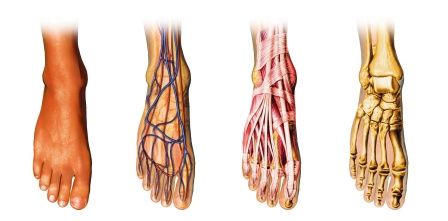
Marmas in the feet
In the pada we can find the below mentioned Marma’s:
Kshipra Marma –
Location: This Marma is located in the first inter-metatarsal space (space between big toe and the second toe)
Ingredients of this marma:
- Deep peroneal nerve branch to the great toe
- Combined tendon of abductor hallucis and flexor hallucis brevis
- Bifurcation of the first common digital nerve
- Bifurcation of first dorsal metatarsal artery
Category:
- Structural – Snayu marma (Ligament / tendon / fascia)
- Effect – Kalantara Pranahara Marma (injury causes gradual death or destruction)
Consequence of injury – convulsions and death
Talahridaya Marma –
Location: middle of the sole on the line of the middle toe
Ingredients of this marma:
- Lateral plantar artery
- Medial and lateral plantar nerves
- Oblique head of abductor hallucis muscle
- Quadrates plantaris muscle
- Flexor digitorum brevis
Category:
- Structural – Mamsa marma (Muscle)
- Effect – Kalantara Pranahara Marma (injury causes gradual death or destruction)
Consequence of injury – Pain and death
Kurcha Marma –
Location: on both sides and proximal to Kshipra marma
Ingredients of this marma:
- Tarso metatarsal and inter-tarsal ligaments
- Extensor digitorum brevis
- Dorsalis pedis and dorsal inter-tarsal arteries
- Tendons of extensor digitorum longus, extensor hallucis longus and peroneus tertious muscles
- Branches of deep peroneal nerve
Category:
- Structural – Snayu marma (Ligament / tendon / fascia)
- Effect – Vaikalyakara Marma (injury causes deformity)
Consequence of injury – Bhramana (irregular shape) and Vepana (tremors) of the foot
Kurchashira Marma –
Location: distal and both sides of Gulpha sandhi (ankle joint)
Ingredients of this marma:
- Deltoid, talo-calcaneal and calcaneo-fibular ligaments
- Annular ligaments
- Tendon of tibialis anterior
Category:
- Structural – Snayu marma (Ligament / tendon / fascia)
- Effect – Rujakara Marma (injury causes severe pain)
Consequence of injury – Ruja (pain) and Shopha (swelling / oedema)
Gulpha Marma –
Location: Junction of foot and leg
Ingredients of this marma:
- Ankle joint and distal tibio-fibular articulation
- Medial malleolar ligament
- Anterior ligament
- Longus ligament
- Deltoid ligament
- Posterior ligament
- Anterior talo-fibular ligament
- Posterior talo-calcaneal ligament
- Fibula-calcaneal ligament
- Lateral talo-calcaneal ligament
Category:
- Structural – Sandhi marma (Ligament / tendon / fascia)
- Effect – Rujakara Marma (injury causes severe pain)
Consequence of injury – Ruk (pain in foot), Stabdha pada (rigidity and stiffness of foot) and Khanjata (functional deformity of the foot)
The above said elaboration indicates that the ancient Ayurvedic seers had a brilliant knowledge of the anatomy and physiology of the foot, pathology and prognosis of foot related diseases, just like in case of any other disease.
The marma’s or vital structures (points) located in foot like any other marma’s of the body, on getting injured causes pain, stiffness, rigidity, functional deformity, swelling, irregular shape and tremors in the foot. Big injuries leading to severe bleeding can also cause gradual death or immediate death.
Thus, if the foot and foot health is maintained by proper foot care and by administering effective Ayurvedic procedures like Padabhyanga we can not only cure the above said conditions but also prevent them, including painful conditions like Sciatica.
Research
- Functional magnetic resonance imaging (fMRI) studies at University School of Medicine study in Japan examined the relationship between brain activity and the areas in the feet called reflex areas. They showed that when reflex stimulation was applied to specific areas of the foot, the part of the brain that corresponds with that somato-sensory area was activated.
- Other study measured brainwave activity and cortisol stimulation from foot reflexology suggest a rise in alpha frequencies where the brain is more relaxed
- Research was conducted by Jesus Manzanares, MD from Spain – to study effective duration for foot reflexology application. Changes in brainwave amplitudes to Theta waves after a specific duration of reflexology suggest when it is most effective. This shows that nerve impulses occur via sensitive peripheral nerves to brain structure where the connection between a foot reflex area and a concrete point of the body takes place.
- The findings showed the reflexological stimulation induced a somato sensory process corresponding to the stimulated reflex area and that a neuroimaging approach can be used to examine the basis of relexology effects.
Read related – Somatotopical relationships between cortical activity and reflex areas in reflexology: a functional magnetic resonance imaging study.
- Foot discomfort is often said to be a symptom of anxiety. Thus Padabhyanga might relieve anxiety which is a symptom related to the whole body.
Read related – Foot Discomfort an Anxiety Symptom?
To end up:
Foot might be placed at the lower end..but it makes you a traveller through the core of time and experience the life at its best..it connects you to the Earth and is responsible for your evolution
Prevention is better than cure.
You can experience Padabhyanga in spite of being healthy…it further rejuvenates and fortifies your health…and you are assured to keep many diseases at bay.
Some good words about foot
‘I will not let anyone walk through my mind with their dirty feet’ – Mahatma Gandhi
‘And forget not that the Earth delights to feel your bare feet and the winds long to play with your hair’ – Kahlil Gibran, The Prophet
Foot massage after food?
Usually any type of massage is given 1 hour before or after taking food. When the food is taken and digestion sets in, Kapha will be dominant. Massage helps to balance Vata Dosha. Hence, it is not ideal to do massage when Kapha is dominant.










16 comments
Ade Adesanya
Greetings! I’ll like a consultation with you
Gaurav
Which oil is suggested for improving eye health?
Dr J V Hebbar MD(Ayu)Author
Maha Narayana taila
v.r.k.raman
v.r.k. raman.
excellent ,scholarly article. Many ladies wear high-heel
shoes to appear taller. How does it affect foot-health?
2. contra-indications :- Can plain massage without oil,
be done every night to get good sleep, even though one may
be having some of the health problems listed in the
paragraph-“contra-indications” ?
v.r.k.raman
v.r.k.raman. thanks for the answer.
S ahere
Can this be done while pregnant?
Mohinee Gurjar
Thank you very much for this article. It gives clear information, which is easily understood by layman if read with interest. Great applaudable work indeed. Grateful to the author and website. Pranaam..
Saratha SN
Great explanation and directions. Thank you!
Dr J V Hebbar MD(Ayu)Author
Amla oil can be applied over feet at night.
Shubhangi karve
Which oil should be used for leg stiffness??
Lai Yoke
Namaskar
What I can use to soak my feet? Any particular metal bucket or ….
Thank you
Dr J V Hebbar MD(Ayu)Author
Any metal pot or mud pot is fine to use.
Sarita
What is the reason for common heel pain??
Dr J V Hebbar MD(Ayu)Author
It could be injury, heel spur, wrong footwear etc.
harpal singh
thank you very much sir, a very nice and informative article
Medha Bahri
Deeply informative!!
Very nice,thanq!